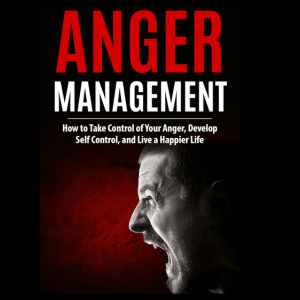Anger Management: Master the Flame Within & Live a Happier Life

Have you ever said something in anger that you regretted later? Or maybe you’ve felt your blood boil over something small and insignificant? You’re not alone. In “Anger Management: How to Take Control of Your Anger, Develop Self Control, and Live a Happier Life”, Bill Andrews dives deep into one of the most misunderstood emotions—anger—and offers a practical roadmap to help you take control before it takes control of you.
This comprehensive guide delves into the psychological roots of anger, explores its effects on daily life, and provides actionable strategies for transforming this intense emotion into a tool for self-awareness and growth. Through 15 well-structured chapters, Andrews walks readers through a journey of self-discovery, emotional regulation, and ultimately, peace.
Whether you’re someone who struggles with occasional outbursts or someone dealing with chronic anger, this book promises not just solutions but a transformational mindset shift.
Book Overview
The book is divided into 15 distinct chapters, each tackling a specific aspect of anger, from identifying its sources to applying real-life coping techniques. The tone is encouraging, non-judgmental, and accessible—making it ideal for readers at any stage of their emotional wellness journey.
Chapter-by-Chapter Breakdown and Review
Chapter 1: Understanding What Anger Really Is
Andrews begins by laying the groundwork: defining what anger is and how it differs from other emotions like frustration or irritation. He explains that anger is a secondary emotion, often masking deeper feelings such as fear, hurt, or disappointment. This chapter helps readers differentiate between healthy and unhealthy expressions of anger.
Key Message:
Understanding the root causes of your anger is the first step toward controlling it.
Chapter 2: Why Do We Get Angry?
Here, Andrews dives into the triggers of anger, exploring both internal and external factors. He discusses personality types prone to anger, past experiences, and societal influences. By analyzing these causes, readers begin to see patterns in their behavior.
Key Teaching:
Recognizing your personal triggers allows you to anticipate and manage anger before it escalates.
Chapter 3: The Physical Effects of Anger
This chapter focuses on the physiological impact of anger —how it affects the body, from increased heart rate and blood pressure to long-term risks like heart disease. Andrews emphasizes the importance of viewing anger not just as an emotional issue but also a health concern.
Insightful Takeaway:
Managing anger isn’t just about emotional control—it’s about preserving your physical health.
Chapter 4: The Emotional Toll of Uncontrolled Anger
Andrews continues by discussing the emotional consequences of unchecked anger, including depression, anxiety, guilt, and shame. He highlights how suppressed anger can lead to passive-aggressive behaviors or even self-sabotage.
Important Lesson:
Unresolved anger doesn’t just affect others—it harms the person experiencing it most.
Chapter 5: The Impact of Anger on Relationships
One of the most relatable chapters, this section explores how anger damages personal and professional relationships. Using real-life examples, Andrews shows how arguments, blame-shifting, and resentment erode trust and intimacy.
Takeaway:
Learning to communicate without aggression is key to maintaining healthy connections.
Chapter 6: Recognizing the Signs of Problem Anger
In this chapter, readers learn how to identify whether they suffer from chronic or problematic anger. Andrews outlines signs such as frequent irritability, road rage, and verbal or physical aggression.
Practical Advice:
Self-assessment tools and reflection questions help readers determine if they need to seek further help.
Chapter 7: The Role of Perception in Anger
Perception plays a huge role in how we interpret events. Andrews introduces the concept of cognitive distortions —such as black-and-white thinking or overgeneralization—that fuel anger unnecessarily.
Core Concept:
Changing how you perceive situations can dramatically reduce your emotional response.
Chapter 8: Controlling Your Thoughts to Control Your Emotions
Building on the previous chapter, this one teaches readers how to reframe negative thoughts using cognitive-behavioral techniques. Andrews explains how altering internal dialogue can prevent anger from escalating.
Useful Technique:
Thought-stopping and positive affirmations are introduced as effective tools.
Chapter 9: Breathing Techniques and Relaxation Strategies
Andrews shifts focus to physical calming methods . He details breathing exercises, progressive muscle relaxation, and mindfulness practices designed to bring immediate relief during moments of anger.
Helpful Tip:
Simple breathing techniques can be used anywhere, anytime to regain composure.
Chapter 10: Communication Skills for Managing Anger
Healthy communication is essential to anger management. This chapter covers active listening, assertiveness, and conflict resolution. Readers learn how to express needs without hostility and listen without defensiveness.
Key Skill:
Assertive communication fosters respect and reduces misunderstandings.
Chapter 11: Setting Boundaries Without Being Angry
Andrews addresses the challenge of setting limits without triggering anger in oneself or others. He discusses how unclear boundaries can lead to resentment and how to establish them respectfully.
Lesson Learned:
Boundaries are not about control—they’re about self-respect and clarity.
Chapter 12: Dealing with Other People’s Anger
This chapter is particularly valuable for those dealing with angry partners, coworkers, or family members. Andrews offers advice on staying calm, de-escalating tense situations, and protecting your own emotional space.
Wise Advice:
You cannot control others’ emotions, but you can control how you respond.
Chapter 13: Forgiveness and Letting Go
Forgiveness is presented as a powerful tool for emotional healing. Andrews distinguishes between forgiveness and condoning bad behavior, emphasizing that letting go benefits the forgiver more than anyone else.
Transformative Insight:
Holding onto grudges keeps anger alive—forgiveness sets you free.
Chapter 14: Creating a Lifestyle That Reduces Anger
In this chapter, Andrews encourages readers to make broader lifestyle changes—like improving diet, exercising regularly, getting enough sleep, and practicing gratitude—to support emotional stability.
Holistic Perspective:
Emotional health is deeply connected to physical and mental habits.
Chapter 15: Staying on Track and Seeking Help When Needed
The final chapter serves as a motivational conclusion , reminding readers that progress takes time. Andrews reinforces the importance of patience, self-compassion, and seeking professional help if necessary.
Encouraging Final Note:
Anger management is a lifelong journey—but every small step leads to greater peace.
Author’s Main Message and Themes
Throughout the book, Bill Andrews conveys a consistent message: you are not defined by your anger. It is a natural emotion that becomes problematic only when left unchecked. His approach is rooted in empathy, science, and practicality.
Core Themes:
- Self-Awareness: Knowing yourself and your triggers is the foundation of emotional control.
- Empowerment: You have the power to change how you react to situations.
- Compassion: Both for yourself and others, especially when emotions run high.
- Balance: Emotional intelligence comes from balancing logic and feeling.
- Growth: Anger can be a catalyst for personal development if managed properly.
Strengths of the Book
- Accessible Language: No jargon-heavy psychology terms; everything is explained clearly.
- Actionable Advice: Every chapter ends with practical tips or exercises.
- Real-Life Relevance: Examples and scenarios are relatable across age groups and backgrounds.
- Well-Structured: Logical flow from understanding anger to applying strategies.
- Encouraging Tone: Never shaming or blaming—always supportive.
Who Should Read This Book?
This book is ideal for:
- Individuals struggling with frequent anger outbursts
- Those looking to improve interpersonal relationships
- Parents wanting to model healthy emotional expression
- Professionals aiming to enhance workplace communication
- Anyone interested in personal growth and emotional intelligence
It’s also a great resource for therapists, counselors, or educators working with clients on emotional regulation.
Comparison with Similar Books
While there are many books on anger management, “Anger Management” by Bill Andrews stands out for its simplicity, structure, and motivational tone. Compared to titles like “The Dance of Anger” by Harriet Lerner or “Anger: Wisdom for Cooling the Flames” by Thich Nhat Hanh, Andrews’ work is more focused on practical steps rather than deep philosophical insights.
However, it complements more theoretical works by offering a hands-on guide to implementation.
Critical Review: What Could Be Improved?
Despite its strengths, the book does have a few minor drawbacks:
- Depth of Psychological Concepts: Some readers might find certain topics oversimplified. For example, while cognitive distortions are mentioned, they could be explored in more depth.
- Lack of Case Studies: More detailed case studies or testimonials would add richness and credibility.
- Limited Cultural Context: The advice given is largely based on Western psychological frameworks, which may not fully resonate with all cultural backgrounds.
That said, these limitations don’t detract significantly from the overall value of the book.
Practical Applications in Daily Life
What makes this book truly valuable is its applicability. Here are some ways to apply the lessons from “Anger Management” in everyday life:
- Morning Reflection: Start your day by identifying potential triggers and preparing responses.
- Pause and Breathe: Use breathing techniques during stressful moments—at work, in traffic, or during disagreements.
- Journaling: Keep a log of anger episodes to identify patterns and track progress.
- Practice Assertiveness: Replace aggressive language with “I feel” statements.
- Set Healthy Boundaries: Learn to say no without guilt or hostility.
- Forgive Regularly: Make forgiveness a habit—not just for others, but for yourself.
These small habits, practiced consistently, can lead to profound changes over time.
Conclusion: A Must-Read Guide for Emotional Mastery
“Anger Management: How to Take Control of Your Anger, Develop Self Control, and Live a Happier Life” by Bill Andrews is more than just a self-help book—it’s a blueprint for emotional freedom. With clear explanations, compassionate guidance, and practical tools, it equips readers with everything they need to transform anger from a destructive force into a constructive one.
By the end of the book, readers aren’t just learning how to manage anger—they’re discovering how to live a more balanced, mindful, and fulfilling life. Whether you’re dealing with mild irritability or chronic anger, this book offers hope, insight, and a path forward.
If you’ve ever felt overwhelmed by your emotions or frustrated by how your anger affects your life, this book is a must-read. Pick it up, reflect on its teachings, and start your journey toward emotional mastery today.
FAQs (Frequently Asked Questions)
Q1: Is this book suitable for someone who doesn’t struggle with anger?
A1: Absolutely! Even if you don’t consider yourself an angry person, this book enhances emotional awareness and improves communication skills—benefiting everyone.
Q2: Does the book offer exercises or worksheets?
A2: Yes, each chapter includes reflection questions, mini-exercises, and actionable steps to apply the concepts.
Q3: Can this book replace therapy?
A3: While it’s an excellent self-help resource, it’s not a substitute for professional help, especially for those dealing with trauma or severe emotional issues.
Q4: Is the book religious or spiritual in nature?
A4: No, it’s secular and grounded in psychology and practical advice. Spirituality is not a focus.
Q5: How long will it take to notice changes after reading?
A5: Results vary, but with consistent practice of the techniques, most people report noticeable improvements within a few weeks.
Final Verdict
Bill Andrews has crafted a compelling, easy-to-follow guide that demystifies anger and empowers readers to take control. If you’re ready to stop letting anger run your life and start living with intention and peace, this book is your perfect companion.
Ready to transform your relationship with anger?
Pick up a copy of “Anger Management: How to Take Control of Your Anger, Develop Self Control, and Live a Happier Life” today and start your journey toward emotional freedom.

